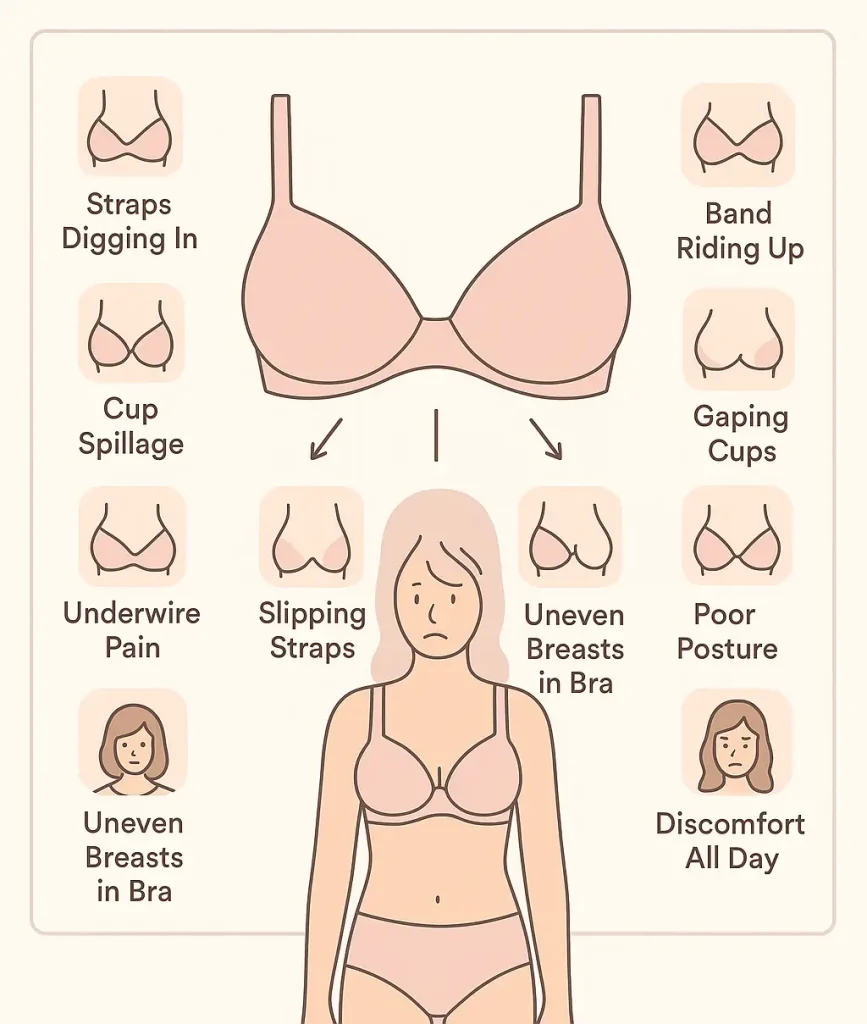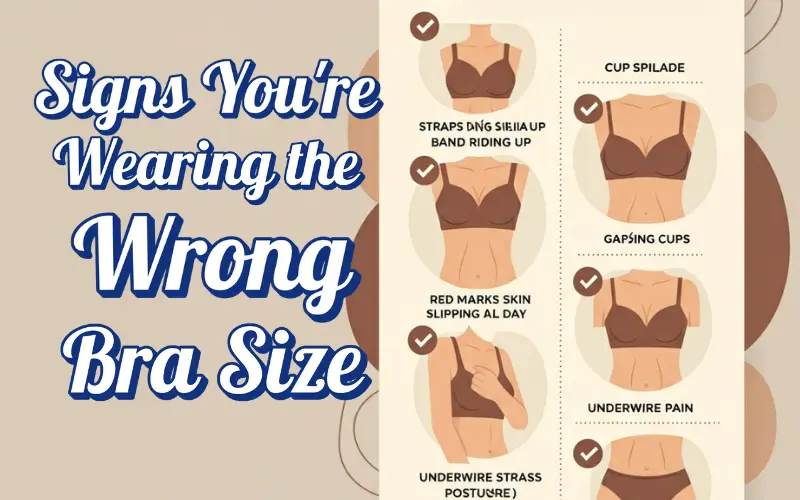12 Signs You are Wearing the Wrong Bra Size
12 Signs You are Wearing the Wrong Bra Size (And How to Fix It)

Did you know that studies show 80% of women wear the wrong bra size? You’re not alone if your bra feels uncomfortable, looks unflattering, or causes pain throughout the day. Finding the right fit isn’t just about comfort, it’s about confidence, posture, and overall well-being. Many women squeeze into ill-fitting bras for years without realizing the impact on their daily lives. From shoulder pain to poor posture, wearing the wrong bra size affects more than you might think.
In this comprehensive bra size guide, we’ll explore the top 12 signs that indicate you’re wearing the wrong bra size, plus practical solutions to help you achieve the comfort and support you deserve.
1. Your Bra Band Rides Up Your Back
One of the most obvious bra fitting mistakes is when your band constantly creeps up your back throughout the day. A properly fitted bra should sit parallel to the floor, creating a straight line across your back.
- Why does this happen?
- Your band size is too large.
- The bra has stretched out over time.
You’re compensating for cups that are too small by going up in band size.
The fix: Try going down a band size and up a cup size. For example, if you’re wearing a 36B, test a 34C. It maintains the same cup volume while providing better band support.
Quick check: Can you pull your band more than two inches away from your back? If yes, it’s too loose.
2. You Experience the Extreme “Quad Boob” Effect
Nothing says “wrong bra size” quite like the quad boob phenomenon, when breast tissue spills over the top of your cups, creating the appearance of four breasts instead of two.
This common fitting issue occurs when:
- Your cup size is too small.
- The bra style doesn’t suit your breast shape.
- The underwire sits on breast tissue instead of underneath.
Real-life example: Sarah, a 32-year-old teacher, wore 34B bras for years because that’s what she’d always worn. After a proper fitting, she discovered she needed a 32D. The spillage disappeared, and her clothes fit better instantly.
Remember: Cup size is relative to the band size. A D cup on a size 32 band is completely different from a D cup on a size 38 band.
3. Painful Red Marks and Indentations
Deep red marks that last for hours after removing your bra signal an ill-fitting undergarment. While some light marking is normal, painful indentations indicate your bra is working too hard in the wrong places.
Common problem areas:
- Shoulders from overtight or narrow straps.
- Under the bust from a band that’s too tight.
- Along the sides from the underwire that doesn’t follow your natural curve.
These marks often result from compensating for other fit issues. If your band is too loose, you might overtighten the straps, causing shoulder pain and marking.
4. Your Straps Won’t Stay Put
Constantly hiking up fallen straps throughout the day? This frustrating issue usually stems from one of these bra fitting mistakes:
- Band too large: When the band doesn’t provide adequate support, the straps work overtime and slip down.
- Straps too loose: But tightening them creates other problems if the real issue is band fit.
- Wrong bra style: Some breast shapes need different strap configurations.
Solution strategy: Start with band fit first. A properly fitted band should provide 80% of your bra’s support. Only then adjust strap tension, they should feel secure without digging into your shoulders.
5. Gaping Cups That Create Unflattering Silhouettes
The space between your breast and the bra cup creates an unflattering shape under clothing and indicates poor fit. But here’s what surprises many women gaping doesn’t always mean your cups are too big.
Why cups gap:
- Wrong cup shape for your breast type.
- Band too large (cups tip forward).
- Cup size is actually too small (breast tissue pushes cup away from chest).
- Hormonal changes affecting breast size.
Try this test: Scoop all breast tissue into the cups, then adjust the band. If gaping persists, you might need a different bra style rather than a different size.
6. Underwire Discomfort and Poking
Your underwire should follow your natural breast crease, sitting flat against your ribcage without poking, pinching, or sitting on breast tissue. If you’re constantly adjusting or experiencing pain, your bra doesn’t fit properly.
Common underwire problems:
- Wire sits on breast tissue (cup too small or wrong shape).
- Wire pokes under the arms (band too large or cup too narrow).
- Wire digs into the sternum (centre panel doesn’t lie flat).
Professional tip: The center gore (fabric between cups) should lie flat against your chest. If it doesn’t, your cups are likely too small or the wrong shape for your breast type.
7. Back Bulges and Side Spillage
Visible bulges around your bra line aren’t necessarily about weight, they’re often about fit. Breast tissue extends from your collarbone to underneath your arms, and an improperly fitted bra can push this tissue in unflattering directions.
How to identify this issue:
- Bulging above or below the back band.
- Tissue pushing out at the sides.
- “Armpit fat” that’s actually displaced breast tissue.
The solution often involves going up in cup size and ensuring your bra has wide enough sides to contain all breast tissue. During fitting, use the “scoop and swoop” method to gather all tissue into the cups.
8. Your Bra Doesn’t Last Long
If you’re replacing bras every few months due to stretched bands, broken wires, or general wear, you might be wearing the wrong size. Properly fitted bras should last 6-12 months with regular wear.
Signs of premature bra breakdown:
- Bands lose elasticity quickly.
- Underwire breaks through fabric.
- Straps stretch out rapidly.
- Cups lose their shape.
When bras work harder than they should to provide support (due to poor fit), they wear out faster. Investing time in proper fitting saves money long-term.
9. Posture Problems and Back Pain
Your bra should improve your posture, not compromise it. Many women don’t realise their chronic back pain or slouching is connected to ill-fitting bras.
How wrong bra size affects posture:
- Insufficient support leads to slouching.
- Overtight straps pull shoulders forward.
- Poor breast support strains back muscles.
- Heavy breasts without proper support cause upper back tension.
Case study: Maria, a nurse, suffered from upper back pain for months. After switching from a 38C to a properly fitted 36DD with good support, her pain decreased significantly within two weeks.
10. You Avoid Certain Clothing Styles
If you find yourself avoiding fitted tops, strapless dresses, or certain necklines because of how your bra looks underneath, it’s time for a fitting reassessment.
Wardrobe red flags:
- Constantly adjusting clothes to hide bra lines.
- Avoiding white or light-colored tops.
- Skipping strapless options entirely.
- Feeling self-conscious in fitted clothing.
The right bra should make you feel confident in any outfit. If your undergarments limit your clothing choices, that’s a clear sign you need better-fitting options.
How to Know If Your Bra Size Is Wrong: The Professional Assessment
Now that you’ve identified potential fit issues, how do you determine your correct size? Here’s a step by step approach:
Step 1: Measure yourself properly.
- Measurements around your ribcage directly under your bust for band size.
- Measurements around the fullest part of your bust for cup calculation.
- Use the difference to determine cup size.
Step 2: Try before you buy.
- Test multiple sizes around your calculated measurements.
- Try different brands, as sizing varies.
- Focus on fit over the size on the label.
Step 3: Assess the fit checklist.
- Band lies flat and level.
- Cups contain all breast tissue without gaping.
- Underwire follows the natural breast line.
- Straps provide light support without digging.
- Centre panel lies flat against the sternum.
Finding Your Perfect Fit: Next Steps
Recognizing these signs is just the beginning. Here’s your action plan for better bra fit:
Professional fitting: Visit a lingerie store with trained fitters. Many department stores offer free fittings, though speciality shops often provide more expertise.
Multiple size testing: Don’t get attached to a specific size. Try your calculated size plus one size up and down in both band and cup.
Style consideration: Different bra styles work for different breast shapes. Full-coverage, demi-cup, and plunge bras all fit differently, even in the same size.
Regular reassessment: Your body changes due to weight fluctuations, hormones, age, and lifestyle. Reassess your fit every 6-12 months.
Conclusion
Wearing the wrong bra size affects millions of women daily, but it doesn’t have to be your reality. By recognizing these 12 warning signs and taking action to find your proper fit, you’ll experience improved comfort, better posture, enhanced confidence, and longer-lasting undergarments.
Remember: bra fitting isn’t about the size on the label– it’s about how the bra functions on your unique body. Don’t let vanity sizing or outdated measurements keep you in ill-fitting bras that compromise your comfort and confidence.
Ready to find your perfect fit? Start with professional measuring, then use this guide to assess how your current bras measure up. Your back, shoulders, and confidence will thank you for making the change to properly fitted undergarments.
Have you experienced any of these signs? What was your biggest surprise when you found your correct bra size? Share your fitting journey and help other women discover the comfort of proper support.







